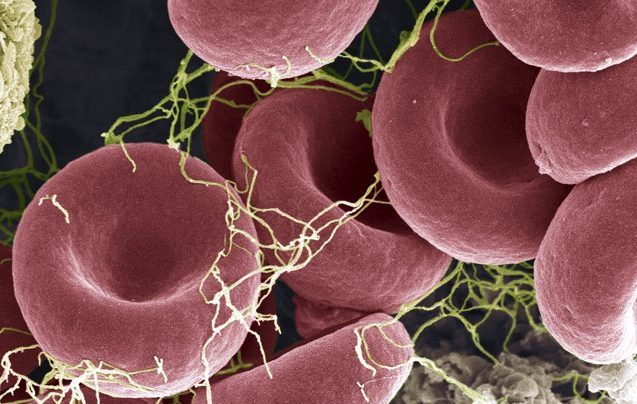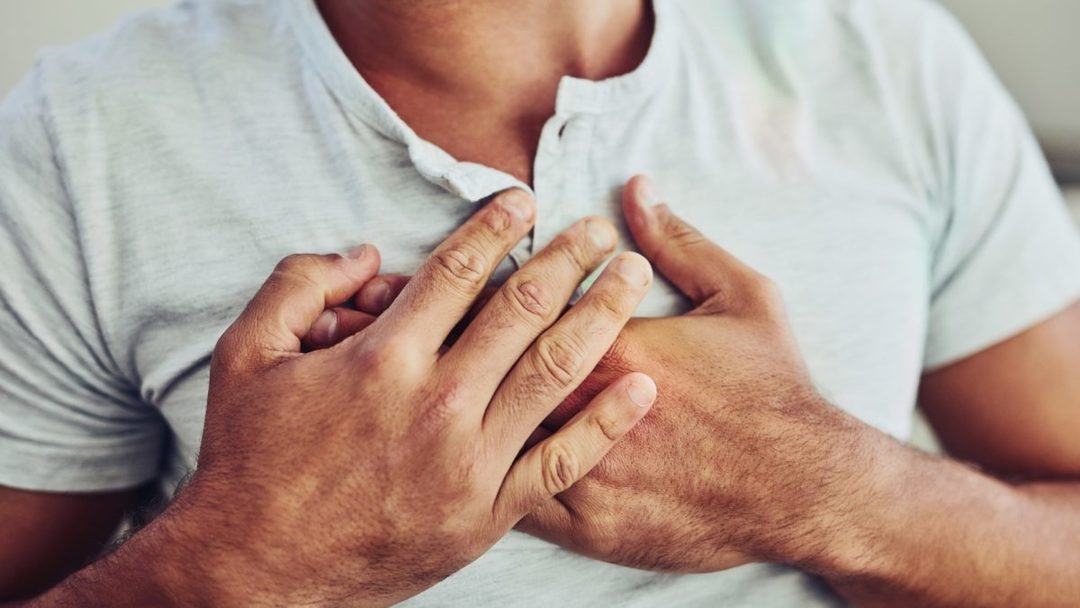Low hemoglobin in the blood: what it says, and what to do to increase it
Decreased hemoglobin in blood (hematological syndrome, characterized by a violation of hemoglobin synthesis due to iron deficiency) - a situation typical for people of any age. Many do not realize the dangers behind this.
In this article, we will look at why women and men have hematological syndrome, what this means, what to do if there is low hemoglobin in the blood, how to increase it at home.
Content
- What is this substance (definition)
- Causes
- Risk factors
- Low hemoglobin in women
- Consequences of low hemoglobin
- Sympomatics
- How to diagnose (norms and deviations)
- Clinical blood test (AS)
- Other tests
- How to increase hemoglobin at home?
- Medicines to increase hemoglobin
What is this substance (definition)
Hemoglobin is a complex iron-containing protein provides transfer oxygen in the body. The composition includes iron, with attaching oxygen molecules, transported through the vessels. It is the main protein without which blood circulation is impossible.
Side function of the main blood protein - transport of carbon dioxide in order to remove it from the body. The iron contained in this protein can also bind to
carbon monoxide (he is even given priority over oxygen), provoking powerful hypoxia. Consequently, fainting and even death. Well, this is in extreme cases. With a low concentration of carbon monoxide, a person may experience milder forms of oxygen deficiency.Protein is produced if there is a lot iron-containing food. It is also important that the digestive system works well and absorbs iron from food. Otherwise, hemoglobin will simply not be synthesized from anything.
Causes
Iron deficiency is the most common cause of low hemoglobin in humans. But there are other reasons, more serious factors leading to a decrease in the hemoglobin content in the blood. These include:
- Lack of essential enzymes - it happens that everything is fine with iron in food, but there are no substances that help to digest food. In addition to extracting the ferrum (which is not easy in itself), you also need to create a molecule, which is very difficult due to the complexity of its chemical structure. For a successful reaction, it is necessary that the body has group vitamins B (there are many of them in meat), C and PP. The most important substance needed for the synthesis of the main oxygen transporter is folic acid, known as vitamin B9.
- Diseases of the digestive tract (GIT) - if a person has liver problems, stomach, it is natural that the necessary enzymes will not be produced in the required amount. However, remember: everything is interconnected. Therefore, a lack of folic acid can also provoke diseases of the gastrointestinal tract.
- Natural decrease in enzyme activity in the elderly (after 50-60 years). However, this does not mean that it is impossible to bring the necessary indicators for hemoglobin back to normal.
- Parasites in the body— people with tapeworms may have 30% less protein than they need. This is one of the main causes of iron deficiency anemia. Parasites arise due to the fact that they adore folic acid.
- Kidney disease and liver cirrhosis- NSThese diseases interfere with the excretion of the hormone erythropoietin from the body, which also disrupts the body's work. As a consequence, a drop in red blood cells may occur. Kidney disease and liver cirrhosis are combined into one group, because often cirrhosis of the liver in womenor provokes men renal failure.
- Dysfunction of the bone marrow. Its job is to create red blood cells (red blood cells). If there are fewer of them, then the hemoglobin content will fall naturally. After all, it is the red blood cells that transport oxygen.
- Internal bleeding— their reason can be any, starting with stomach ulcers and ending with the rupture of small blood vessels. So low hemoglobin may indicate internal bleeding.
Read also:Causes of increased hemoglobin in the blood in men, as manifested, complaints, treatment
Risk factors
Anemia is a common disease and can occur in both men and women of any age and from any ethnic group. Some people may be at greater risk of developing hematologic syndrome than others, including:
- women 20-35 years old;
- during gestation;
- people with poor nutrition;
- people who donate blood frequently;
- infants and children, especially those born prematurely;
- vegetarians who do not replace the lack of meat in the diet with other foods rich in iron.
Low hemoglobin in women

Pregnancy, severe menstrual bleeding, and uterine fibroids — these are the main reasons why women have low hemoglobin levels in their blood.
Difficult menstrual bleeding occurs when the bleeding lasts longer than usual during regular periods. According to the Centers for Disease Control and Prevention, typical menstrual bleeding lasts 4 to 5 days, and the amount of blood lost ranges from 2 to 3 tablespoons. Women with excess menstrual bleeding usually bleed for more than 7 days and lose twice as much blood as normal.
According to the National Heart, Lung and Blood Institute, about 20% of women aged 20-35 suffer from low hemoglobin. Pregnant women are more likely to suffer from hematologic syndrome because they need a lot of blood to keep the baby in the womb.
Myoma of the uterus— a cause of low hemoglobin levels in women that often does not cause symptoms. A benign tumor that occurs in the muscle layer of the uterus can cause heavy menstrual bleeding, leading to hematological syndrome.
Consequences of low hemoglobin
If there is a lot of carbon monoxide, the "working hemoglobin" will be less, part of it is blocked. The effect is the same as with a reduced content of oxygen transporting molecules. This is the main danger: chronic oxygen starvation (hypoxia) sets in, which covers all organs. If hypoxia is prolonged, then the body gradually dies.
With a low hemoglobin content in the blood, organs develop anemia (a group of clinical and hematological syndromes), all body functions suffer, starting mental processes (it becomes difficult to concentrate, drowsiness appears) and ending with a dysfunction of the gastrointestinal tract, immune systems.
A low oxygen content in the body can provoke an ischemic heart attack and strokeand if the amount of this important protein is constantly decreasing, this is a serious reason to think. Doctors advise you to be examined several times over a period of time so that a trend can be determined.
Sympomatics
All symptoms can be divided into subjective and objective. The first are those that cannot be measured, but are experienced by the patient. Objective symptoms can be determined medically. Subjective signs of low hemoglobin:
- Dizziness. The consequence of oxygen starvation of the brain.
- Dyspnea. It occurs due to the fact that the lungs are trying to compensate for the lack of oxygen with a large amount of air.
- Noise in ears and head.
- Gets lost menstrual cycle. In extreme cases, there is no menses at all.
- Anorexia, no appetite, food disgusting.
Read also:DIC syndrome (disseminated intravascular coagulation)
These symptoms indicate not only a reduced amount of oxygen in the cells, but also about violations of the acid-base balance. If the amount of the substance decreases to 49 g per liter, then acidification of the blood occurs. This is a very dangerous condition, leading to vomiting, diarrhea, respiratory depression and blood circulation.
There is another category of subjective symptoms - dystrophic. They are characterized by a violation of the integrity of tissues and organ structure. You can talk about low content if:
- nails become brittle;
- strange addictions to substances that are not food, such as dirt, ice, or clay;
- dry hair;
- the ends split;
- the tongue turns red;
- the skin turns pale and dries;
- tingling in the limbs is felt.
All these signs indicate that there is low hemoglobin in the blood.
Objective symptoms, as we said earlier, are visible to the naked eye. One of the most common signs - sinus tachycardia. The reason is the same as the shortness of breath. The heart tries to compensate for the lack of oxygen with a faster blood flow. With a stethoscope, you can hear heart murmur. The tremors become much stronger, and blood pressure also decreases.
How to diagnose (norms and deviations)
Doctors can diagnose hematologic syndrome with blood tests. These include:
Clinical blood test (AS)
A CBC is usually the first test doctors do. the amount of all components in the blood is measured, including:
- red blood cells (erythrocytes);
- white blood cells (leukocytes or WBC);
- hemoglobin;
- hematocrit;
- platelets.
CBC provides information that helps diagnose hematologic syndrome. This information includes:
- hematocrit, which is the percentage of blood volume made up of red blood cells;
- hemoglobin level;
- the size of your red blood cells.
The hematocrit rate is 34.9-44.5 percent for adult women and 38.8-50 percent for adult men. The norm of hemoglobin is from 12.0 to 15.5 g. per deciliter for an adult woman and from 13.5 to 17.5 g. per deciliter for an adult male.
In hematologic syndrome, hematocrit and hemoglobin levels are low. In addition, the red blood cells are smaller than usual.
An extensive AS analysis is often performed as part of a routine physical examination. This is a good indicator of a person's overall health. It can be done regularly before surgery. The study is useful for diagnosing this type of anemia.
Other tests
It is possible to confirm the presence of a hematological syndrome in a person with a routine HAK test, but the doctor may also suggest have additional blood tests to determine how serious your anemia is and to prescribe a specific treatment. Doctors can examine blood through an optical device, such a study will provide information:
- the level of the gland in the blood;
- the size and color of red blood cells;
- ferritin level;
- serum iron binding capacity (TIBC);
- latent (unsaturated) iron-binding capacity of blood serum (LVSS).
Ferritin is a complex protein complex that helps preserve iron in the body. Low levels of globular protein complex indicate low iron content. TIBC is used to diagnose the amount of iron-carrying transferrin. Transferrin is a protein that transports iron.
Read also:High levels of potassium in the blood (hyperkalemia)
How to increase hemoglobin at home?

You can increase hemoglobin at home with foods containing folic acid (vitamin B9) and iron. And so, this is what you need to eat:
Foods containing vitamin B9:
- Greens. Folic acid is Latin for “leaf”. If you eat parsley, dill, salad and other mouth-watering herbs, the body will replenish vitamin B9 reserves.
- Vegetables. Any legumes, carrots, pumpkin and other fruits contain huge amounts of vitamin B9. And for women, the improvement of intestinal motility, which is stimulated with the help of vegetables, is still an urgent issue. Eat carrots, turnips, and beets to improve digestion.
- Asparagus. There is a lot of folic acid here - as much as 262 mcg. For people with a reduced content of oxygen-carrying substance, it is simply heaven. Also, asparagus is useful for those who have suffered a heart attack and stroke, as they stimulate the work of the heart. In addition, asparagus is low in calories.
- Citrus and other fruits. It is worth paying special attention to citrus fruits. Orange contains about 10% of the daily value of folate. And the tangerine hybrid, called mineol, is able to provide the body with as much as 80% of the required daily amount. It is also recommended to eat raspberries, pomegranates and bananas, which are also high in folate.
- Whole grains and nuts. It's no secret that heat treatment destroys about 90% of folic acid. You should eat unroasted wheat, oats and nuts.
- Seeds are also useful. Just keep in mind that many people get allergies from them. Fried sunflower seeds are especially harmful in this matter.
- Animal liver. In addition to folic acid, it also contains iron. You can eat pork, chicken and beef liver.
- Eggs. Quail eggs also contain a lot of folic acid.
Iron containing foods:
- beef. Here you can get 22% of your daily iron requirement;
- offal. Many iron contains in the kidneys, the language of animals;
- legumes - soybeans, lentils, peas, beans;
- cereals - buckwheat, oatmeal, barley;
- seaweed;
- sesame seeds, pumpkin seeds and sunflower seeds;
- nuts - hazelnuts, almonds, peanuts;
- dried fruits - dried rose hips, dried apples, dried apricots, raisins, prunes, dates;
Medicines to increase hemoglobin
Attention, any drugs should be prescribed only by a doctor. Self-medication can be hazardous to your health. If you decide to independently approach the issue, then carefully study everything: starting with instructions and ending with the causes of the disease. However, some medications (for example, synthetic vitamins) can be used without a doctor's recommendation. But you should be careful with them too.
Here are some drugs that are taken when hemoglobin levels are low:
- ferrum-lek;
- ffol;
- sideral;
- maltoferFoul.
The specific medicine and dosage is prescribed by your doctor. Too much is harmful. In addition, the dosage of the drug is exclusively individual. Wrong dosage drugs to increase glands irritate the mucous membrane of the gastrointestinal tract.
Now you know why you may have low hemoglobin, the causes and consequences are given in the article, for review, consultation with a specialist doctor is also necessary.



